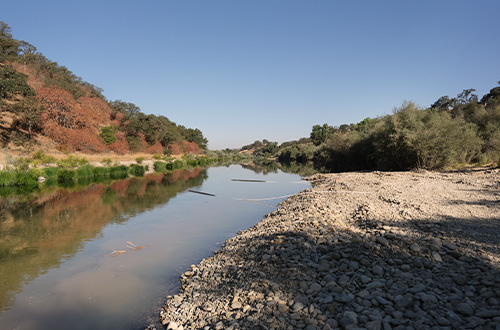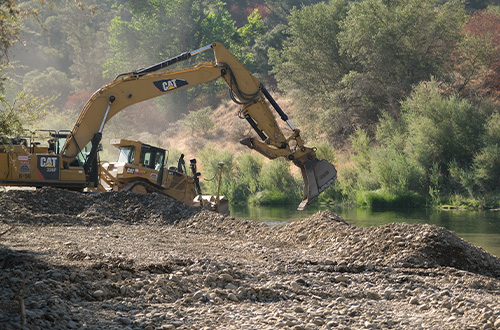The San Francisco Public Utilities Commission (SFPUC) has a long history of environmental leadership. From protecting endangered species to producing clean energy to treating stormwater runoff when others do not, we're committed to responsible stewardship. The latest example is the Old LaGrange Bridge Habitat Restoration Project on the lower Tuolumne River, just east of Modesto in California’s Central Valley.

This project was made possible through partnerships with the Turlock Irrigation District, the Modesto Irrigation District, the SFPUC, and the U.S. Fish and Wildlife Service. Together, we're working to protect and restore native fish populations on the Tuolumne River, a vital water source that provides about 80% of the water for our 2.7 million customers in the Bay Area.
Restoring Habitat for Native Fish
This $7.6 million project creates approximately eight acres of improved spawning and rearing habitat for salmon, trout, and other native fish species in the river. By reclaiming gravel removed from the river during the Gold Rush, cleaning it, and returning it to the Tuolumne, we're creating five spawning areas for fish.
A Glimpse of the Future
The Old La Grange Bridge Habitat Restoration Project is a preview of the future and is the first of many projects to come as part of our longer-term commitment to significantly invest in restoring habitat on the Tuolumne River. This project is part of the Healthy Rivers and Landscapes Program, which will restore more habitat along the Tuolumne River and improve water flows across the Central Valley.

This program involves collaboration between state, federal and local agencies to advance a transformational, watershed-wide approach to increase river flows, restore ecosystems, and strengthen water supply reliability across the state. The approach – sometimes referred to as “voluntary agreements” because parties came together to propose it – is a comprehensive, multi-year alternative to the divisive and top-down Bay-Delta Plan.
Bringing together environmental groups, Native American tribes, public water agencies, and state and federal resource agencies is how we can achieve solutions that are inclusive, science-based, and climate-responsive.
Pooling Resources
By pooling resources and working together, we can take real action to support a healthy river-delta ecosystem in the Central Valley. This includes strategically timed water releases into the rivers, as well as expanded habitat in the Sacramento and San Joaquin Rivers and the Bay Delta. These environmental improvements will be guided by scientific monitoring and collaborative decision-making.
As part of this approach, San Francisco and our irrigation district partners have committed to not only put more water in the Tuolumne River for native fish, but we’ve also committed $64 million in funding to develop and implement other measures that will help increase the survival of native fish, including building more habitat restoration projects like the one near Old La Grange Bridge.
This longer-term effort has already begun. Last year the districts and San Francisco joined with River Partners, the leading California riverway restoration organization, and McBain Associates, a leading restoration design firm, to plan and design projects to help fulfill our commitment to restore the Tuolumne River habitat. We continue to view collaboration and cooperation as the best path forward. The Healthy Rivers and Landscapes Program does just that.
The science San Francisco and the irrigation districts have developed over the last 30 years supports our belief that this approach will work to help restore native fish populations. We’re looking forward to expanding and accelerating the inspiring progress that is unfolding at our Old La Grange Bridge Project.


